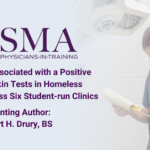Abstract | May 3, 2021
Risk Factors Associated with a Positive Tuberculin Skin Tests in Homeless Populations Across Six Student-run Clinics
Learning Objectives
- Identify general risk factors for tuberculosis
- Identify which specific risk factors increased a homeless patient's risk of a positive TST
- Consider the possibility of screening homeless patients based on tuberculosis risk factors
Background:
Student-run clinics (SRCs) are excellent resources for screening homeless patients for tuberculosis. However, limited grant funding and potential shortages of tuberculin may necessitate allocation of tuberculin skin tests (TST) to patients with increased risk of tuberculosis.
Goals:
To determine which risk factors increase patients’ risk for a positive TST.
Methods:
A retrospective, multisite chart review of homeless patients screened at 6 SRCs between January 1, 2017 through October 1, 2019 was performed. Relative risks (RR) were calculated for multiple categories to determine their impact on TST results.
Results:
Over 33 months, 4,155 patients received TST and attended their follow-up appointment; 3,941 (94.85%) were negative and 214 (5.15%) were positive. When no additional risk factors were present, the following were independently associated with increased risk of a positive TST: A) close contact with an individual with active tuberculosis (RR 5.12, 95% confidence interval (CI) 2.68-9.80, p<0.0001), B) weight 10% or more below ideal body weight (RR 2.32, 95% CI 1.24-4.32, p=0.008), C) diabetes (RR 2.34, 95% CI 1.55-3.53, p=0.0001), and D) incarceration within the last 5 years (RR 1.36, 95% CI 1.004-1.834, p=0.05). Additionally, after controlling for if a
patient had multiple risk factors for tuberculosis, the following were still independently associated with an increased risk of a positive TST: A) close contact with an individual with active tuberculosis (RR 4.21, 95% CI 2.24-7.90, p<0.0001), and B) weight 10% or more below ideal body weight (RR 1.89, CI 1.03-3.46, p=0.04). Overall, patients with any risk factors were 1.52 times more likely to have a positive TST than those with none (RR 1.52, 95% CI 1.17-1.98, p=0.002).
Conclusions:
This study identified risk factors associated with a positive TST. When necessary, screening for these risk factors may help allocate TST to those at greatest risk for tuberculosis.

